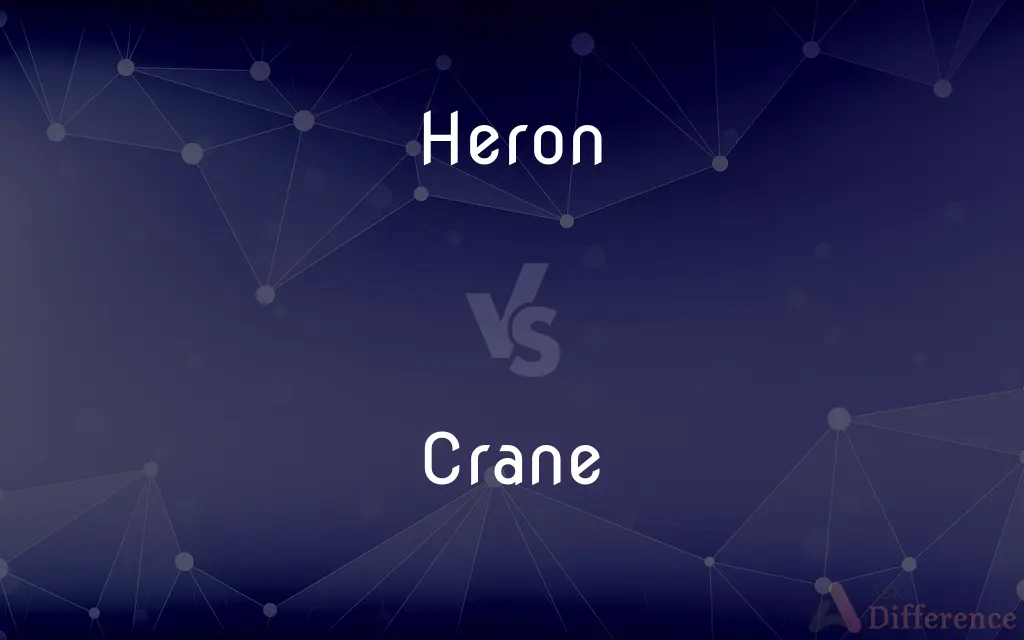Heron vs. Crane — What's the Difference?
By Tayyaba Rehman & Fiza Rafique — Updated on March 20, 2024
Herons are primarily solitary birds known for their stealth and patience in hunting, while cranes are more social, known for their elaborate dances and strong migratory patterns.

Difference Between Heron and Crane
Table of Contents
ADVERTISEMENT
Key Differences
Herons are characterized by their solitary nature, often found hunting alone in wetlands and along water bodies. They are stealthy hunters, standing still for long periods before striking their prey with lightning speed. Whereas, cranes are more social birds, usually seen in pairs or larger flocks. They are known for their complex mating dances, which involve a series of intricate steps, jumps, and calls.
The physical appearance of herons includes a long neck, which is typically folded into an "S" shape during flight, and long legs for wading in shallow waters. Their bills are long and pointed, ideal for spearing fish and other aquatic prey. On the other hand, cranes exhibit a straighter neck in flight and also have long legs, but their bills are more varied in shape, often adapted to their specific diet, which can include plants, insects, and small animals.
Herons have a more extensive range of habitats, adapting to almost any freshwater or saltwater environment close to their food sources. They are often found alone, camouflaged among reeds and plants. Cranes, however, prefer more open spaces like wetlands, fields, and grasslands, where they can gather in groups, especially during migration or breeding seasons.
When it comes to nesting, herons are known to build their nests in trees, bushes, or on the ground, depending on the species. They use sticks and vegetation to create a platform-like nest. Cranes, in contrast, usually nest in shallower waters where they construct their nests from available vegetation, making it more difficult for predators to reach.
Despite their differences, both herons and cranes play significant roles in their ecosystems. Herons are important for controlling fish and insect populations, while cranes are often seen as symbols of luck and longevity in various cultures, contributing to biodiversity through their seed dispersal and foraging activities.
ADVERTISEMENT
Comparison Chart
Social Behavior
Solitary, except during breeding season.
Social, forming pairs or large flocks.
Hunting Style
Stealthy, waits for prey.
Varied, including dancing for mating.
Flight Appearance
Neck retracted in an "S" shape.
Neck straight out.
Habitat
Freshwater and saltwater environments.
Wetlands, fields, and grasslands.
Nesting
In trees, bushes, or ground.
In shallow waters, harder for predators to access.
Compare with Definitions
Heron
A bird known for its solitary hunting, long legs, and neck, which it uses to catch fish and other prey in water bodies.
The heron stood silently by the water's edge, waiting for fish to come near.
Crane
A bird noted for its social nature, long legs, and neck, and known for its migratory behavior and elaborate mating dances.
The crane performed a complex dance to attract its mate, complete with bows and jumps.
Heron
Adaptable to a wide range of aquatic environments, from freshwater to saltwater.
Herons can be found in nearly every wetland habitat around the world.
Crane
Distinguished by a straight neck in flight and a varied diet reflected in its beak shape.
The crane's straight neck while flying distinguishes it from herons.
Heron
Prefers to hunt and live alone outside of the breeding season.
Unlike many birds, the heron spends most of its time alone.
Crane
Lives in flocks and has complex social behaviors, including dancing.
Cranes gather in large flocks during migration, creating a spectacular sight.
Heron
Has a distinctive "S" shaped neck when flying and a pointed beak.
The heron's long, pointed beak is perfect for catching fish.
Crane
Prefers open spaces such as wetlands and grasslands for living and breeding.
The cranes nested in the shallow waters of the marsh, away from predators.
Heron
Builds large nests from sticks and vegetation, often in trees.
The heron's nest, high in the tree, was a mass of sticks and twigs.
Crane
Constructs nests in shallow water to protect from predators.
Cranes use vegetation to build their nests in water, making it challenging for predators to approach.
Heron
The herons are long-legged, long-necked, freshwater and coastal birds in the family Ardeidae, with 64 recognised species, some of which are referred to as egrets or bitterns rather than herons. Members of the genera Botaurus and Ixobrychus are referred to as bitterns, and, together with the zigzag heron, or zigzag bittern, in the monotypic genus Zebrilus, form a monophyletic group within the Ardeidae.
Crane
Any of various large wading birds of the family Gruidae, having a long neck, long legs, and a long bill.
Heron
A large fish-eating wading bird with long legs, a long S-shaped neck, and a long pointed bill.
Crane
A similar bird, such as a heron.
Heron
Any of various wading birds of the family Ardeidae, having a long neck, long legs, a long pointed bill, and usually white, gray, or bluish-gray plumage.
Crane
A machine for hoisting and moving heavy objects by means of cables attached to a movable boom.
Heron
A long-legged, long-necked wading bird of the family Ardeidae.
Crane
Any of various devices with a swinging arm, as in a fireplace for suspending a pot.
Heron
Any wading bird of the genus Ardea and allied genera, of the family Ardeidæ. The herons have a long, sharp bill, and long legs and toes, with the claw of the middle toe toothed. The common European heron (Ardea cinerea) is remarkable for its directly ascending flight, and was formerly hunted with the larger falcons.
Crane
To hoist or move with or as if with a crane.
Heron
Greek mathematician and inventor who devised a way to determine the area of a triangle and who described various mechanical devices (first century)
Crane
To strain and stretch (the neck, for example) in order to see better.
Heron
Gray or white wading bird with long neck and long legs and (usually) long bill
Crane
To stretch one's neck toward something for a better view.
Crane
To be irresolute; hesitate.
Crane
Any bird of the family Gruidae, large birds with long legs and a long neck which is extended during flight.
Crane
Ardea herodias, the great blue heron.
Crane
A mechanical lifting machine or device, often used for lifting heavy loads for industrial or construction purposes.
Crane
An iron arm with horizontal motion, attached to the side or back of a fireplace for supporting kettles etc. over the fire.
Crane
A siphon, or bent pipe, for drawing liquors out of a cask.
Crane
(nautical) A forked post or projecting bracket to support spars, etc.; generally used in pairs.
Crane
(obsolete) The cranium.
Crane
(ambitransitive) To extend (one's neck).
Crane
(transitive) To raise or lower with, or as if with, a crane.
Crane
(intransitive) To pull up before a jump.
Crane
A wading bird of the genus Grus, and allied genera, of various species, having a long, straight bill, and long legs and neck.
Crane
Any arm which swings about a vertical axis at one end, used for supporting a suspended weight.
Crane
A machine for raising and lowering heavy weights, and, while holding them suspended, transporting them through a limited lateral distance. In one form it consists of a projecting arm or jib of timber or iron, a rotating post or base, and the necessary tackle, windlass, etc.; - so called from a fancied similarity between its arm and the neck of a crane See Illust. of Derrick.
Crane
An iron arm with horizontal motion, attached to the side or back of a fireplace, for supporting kettles, etc., over a fire.
Crane
A siphon, or bent pipe, for drawing liquors out of a cask.
Crane
A forked post or projecting bracket to support spars, etc., - generally used in pairs. See Crotch, 2.
Crane
The American blue heron (Ardea herodias).
Crane
To cause to rise; to raise or lift, as by a crane; - with up.
What engines, what instruments are used in craning up a soul, sunk below the center, to the highest heavens.
An upstart craned up to the height he has.
Crane
To stretch, as a crane stretches its neck; as, to crane the neck disdainfully.
Crane
To reach forward with head and neck, in order to see better; as, a hunter cranes forward before taking a leap.
The passengers eagerly craning forward over the bulwarks.
Crane
United States writer (1871-1900)
Crane
United States poet (1899-1932)
Crane
Lifts and moves heavy objects; lifting tackle is suspended from a pivoted boom that rotates around a vertical axis
Crane
Large long-necked wading bird of marshes and plains in many parts of the world
Crane
Stretch (the neck) so as to see better;
The women craned their necks to see the President drive by
Common Curiosities
Are heron and crane nests similar in construction?
Herons build nests in trees or bushes, while cranes build theirs in shallow water, using vegetation to protect against predators.
Why do cranes dance?
Cranes perform elaborate dances as part of their mating rituals and to strengthen pair bonds.
Are herons or cranes more adaptable to different environments?
Herons are more adaptable, living in a variety of aquatic environments, from saltwater to freshwater.
How do herons and cranes differ in their social behavior?
Herons are mostly solitary except during breeding, while cranes are more social and live in flocks.
Do cranes migrate?
Yes, cranes are known for their long migratory journeys, often traveling thousands of miles.
Can herons and cranes be found in the same habitats?
While both can be found near water, herons adapt to a wider range of aquatic environments, whereas cranes prefer open spaces like wetlands and grasslands.
Do herons and cranes have the same diet?
Both primarily eat fish and small aquatic animals, but cranes have a more varied diet, including plants and insects.
What role do cranes play in ecosystems?
Cranes contribute to biodiversity and ecosystem health through seed dispersal and their foraging activities.
What challenges do herons face?
Herons face threats from habitat loss, pollution, and human disturbance.
How do herons communicate?
Herons use a variety of calls and postures to communicate, especially during the breeding season.
What distinguishes a heron from a crane when flying?
Herons fly with their necks retracted in an "S" shape, while cranes fly with their necks straight out.
What is the significance of cranes in culture?
Cranes are symbols of luck, longevity, and fidelity in many cultures.
How do herons hunt?
Herons hunt by standing still in water, waiting to spear fish or prey with their long beaks.
Can cranes be found in urban areas?
While cranes prefer natural open spaces, some species adapt to urban environments, especially if there are suitable wetlands.
What conservation efforts are in place for cranes?
There are international conservation efforts, including habitat protection and restoration
Share Your Discovery

Previous Comparison
Gout vs. Bunion
Next Comparison
Polymer vs. MacromoleculeAuthor Spotlight
Written by
Tayyaba RehmanTayyaba Rehman is a distinguished writer, currently serving as a primary contributor to askdifference.com. As a researcher in semantics and etymology, Tayyaba's passion for the complexity of languages and their distinctions has found a perfect home on the platform. Tayyaba delves into the intricacies of language, distinguishing between commonly confused words and phrases, thereby providing clarity for readers worldwide.
Co-written by
Fiza RafiqueFiza Rafique is a skilled content writer at AskDifference.com, where she meticulously refines and enhances written pieces. Drawing from her vast editorial expertise, Fiza ensures clarity, accuracy, and precision in every article. Passionate about language, she continually seeks to elevate the quality of content for readers worldwide.
















































